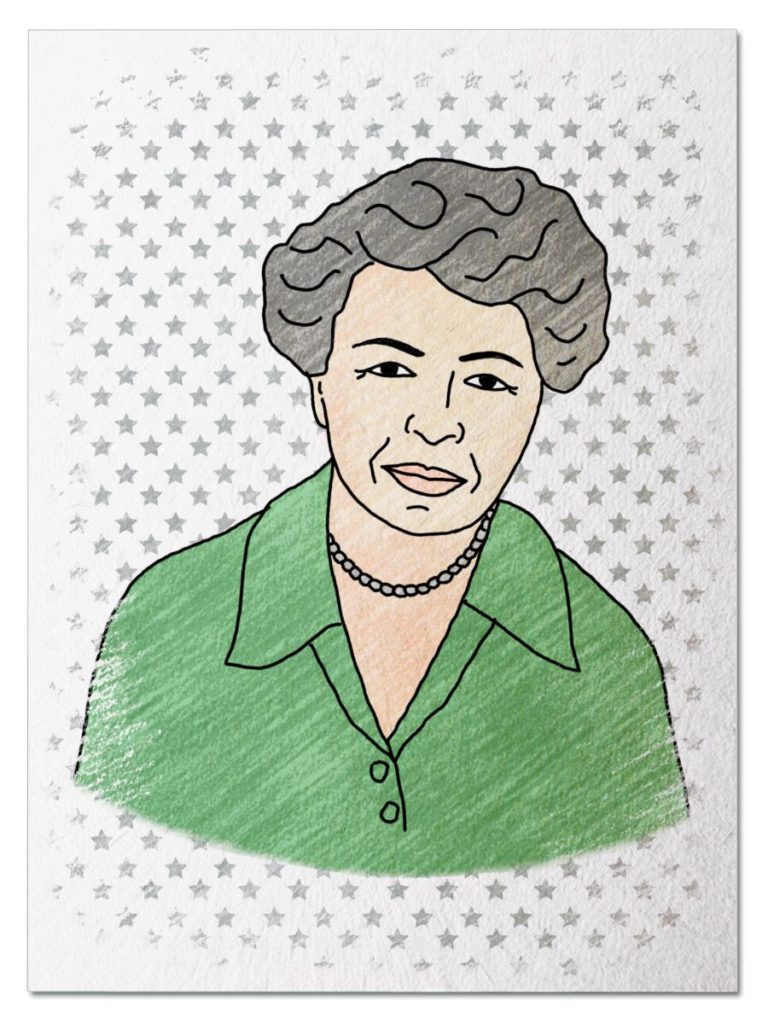
Culture Changer
She was an orphan by the time she was 10 years old and had a lonely childhood. Then, she went to boarding school in England, grew in confidence, and found her voice. After returning to America, she met and married her distant cousin. She stood by her husband’s side, from local politics to the White House. She served as First Lady for 12 years, redefining the role and championing the rights of all Americans along the way. After her husband died, she thought her public life was over. Little did she know, she was about to embark on some of the most important work of her career. Step into the halls of the United Nations in 1945 and meet Eleanor Roosevelt….
Her Ruby Shoe Moment
The Power of the Wand
Her Yellow Brick Road
Brains, Heart & Courage
Glinda’s Gallery
Just the Facts
Her Ruby Shoe Moment
Eleanor Roosevelt was deep in thought as she left the White House. It was December, 1945 and President Harry Truman just asked her to serve as the first American delegate to the newly-formed United Nations.
Eleanor thought her career in public service was over when FDR died and hesitated to jump back into the public’s eye. In addition, she didn’t have any official diplomatic experience. But then she realized that all her experience led her to this moment — she promoted the rights of all Americans while she was first lady. Eleanor found that she couldn’t resist President Truman’s offer. She was ready for a new challenge.
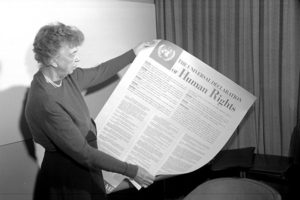
Eleanor and the Declaration of Human Rights (United Nations)
Initially, the goals of the United Nations did not include the promotion of human rights. However, the suffering by millions of people during World War II couldn’t be ignored. Eventually, the UN created a Human Rights Commission (“Commission”), which was overseen by the Third Committee of Social, Humanitarian, and Cultural Affairs. There were nine initial members, .
On April 26, 1946, the initial representatives of the Commission met to determine the primary mission and structure of the Commission going forward. They elected Eleanor as its first chairperson, unanimously. In addition, the Commission determined that one of their primary missions would be to create an international bill of rights.
The first meeting of the full Commission started on January 27, 1947. It lasted until February 10, 1947. Once again, Eleanor was unanimously elected as chair. Her first order of business was to discuss, conceptually, what principles should be included in the international bill of rights. During that first meeting, Eleanor noticed two trends: (1) delegates from democratic countries focused on the rights of individuals, while delegates from communist countries focused on the common good; and (2) delegates from industrialized nations focused on political rights, while delegates from developing nations focused on social and economic rights. She realized that the Declaration had to allow each member nation to fulfill its goals, regardless of economic system.
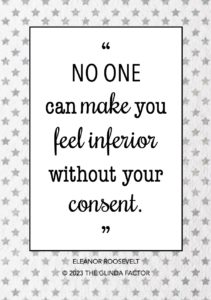 The Commission appointed a few members to prepare a draft bill of rights based on the discussions at the meeting. Not surprisingly, Eleanor was one those selected. They spent six months creating a first draft of the Declaration of Human Rights (“Declaration”), which they presented to the full Commission in December, 1947. It was discussed at length and Eleanor was tasked with revising the Declaration based on the Commission’s comments.
The Commission appointed a few members to prepare a draft bill of rights based on the discussions at the meeting. Not surprisingly, Eleanor was one those selected. They spent six months creating a first draft of the Declaration of Human Rights (“Declaration”), which they presented to the full Commission in December, 1947. It was discussed at length and Eleanor was tasked with revising the Declaration based on the Commission’s comments.
Finally, the Commission presented a draft of the Declaration to the Third Committee at its meeting in May, 1948. Eleanor oversaw another round of revisions and presented a revised Declaration to the Third Committee in Paris during the fall of 1948.
Eleanor was unhappy with the discussion — every word was debated; every idea was reviewed; and ideas were revisited time and time again. She had spent 2 years drafting the Declaration, and the Third Committee wanted to rewrite it at the eleventh hour. But she refused to give up. Finally, after significant revisions, the Third Committee approved the Declaration at 3:00 AM on December 7.
The UN General Assembly discussed the Declaration two days later, on December 9. The USSR delegate proposed further revisions, but was rejected. The UN General Assembly unanimously approved the Universal Declaration of Human Rights at midnight on December 10 (the USSR abstained). After the voting concluded, the entire General Assembly gave Eleanor a well-deserved standing ovation.
The Power of the Wand
Eleanor Roosevelt did more to advance the cause of human rights globally than almost anyone in American history. Some people estimate that she devoted over 3,000 hours to the cause. And Eleanor considered the Universal Declaration of Human Rights to be her greatest accomplishment.
The Universal Declaration of Human Rights served as the foundation of civil rights movements and inspired hundreds of non governmental human rights groups around the world. Its principles have become law by some nations and included in the constitutions of new nations. It has lived up to Eleanor’s hope that it would become “a document of moral force in the world.”
Her Yellow Brick Road
Eleanor served as the First Lady of the United States for 12 years. When FDR was first elected in 1933, she was nervous about becoming first lady. She didn’t want to give up her independence, didn’t care about style or decorations, and wasn’t interested in the traditional hostess duties. But then, Eleanor realized how much influence she could have in the role. So she made the most of it.
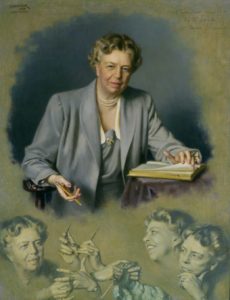
Eleanor Roosevelt portrait as first lady (White House Historical Association)
Eleanor re-defined the role of first lady. In fact, she was so busy that she needed staff to help her. She wrote a daily newspaper column called My Day, which appeared 6 days per week from 1935-1962. She held press conferences, most of which were only open to female journalists (she held 348 press conferences while first lady). She hosted a radio show, wrote books, and made countless appearances all over the country. She received over 300,000 letters per year while first lady, and tried to respond personally to as many as she possibly could.
While serving as first lady, Eleanor traveled all over America and acted as FDR’s eyes and ears. She made visits, attended meetings, and gave speeches on his behalf. Then, she told him about the nation’s suffering and suggested policy changes. She viewed herself as FDR’s “moral compass.”
Before long, Eleanor became a champion for those with no voice in the government. She advocated for women’s rights, civil rights, children’s health, injured soldiers, Jewish refugees, trade unions, and coal miners — the list goes on and on. In fact, she helped to arrange for Marian Anderson’s concert on the National Mall (another Glinda Gal). She also opposed any Japanese American discrimination during World War 2, and tried to talk FDR out of signing Executive Order 9066 (which imprisoned Japanese Americans in camps).
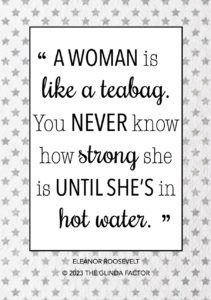 During World War II, Eleanor traveled thousands of miles to visit American troops (her military plane was called Our Eleanor). She chatted with injured soldiers, inspected Army supplies, toured Red Cross hospitals, visited GI rest centers, and brought messages home to families from wounded men. She was tireless in her support.
During World War II, Eleanor traveled thousands of miles to visit American troops (her military plane was called Our Eleanor). She chatted with injured soldiers, inspected Army supplies, toured Red Cross hospitals, visited GI rest centers, and brought messages home to families from wounded men. She was tireless in her support.
Eleanor always spoke with candor and honesty, which wasn’t the norm for women at the time. She was also tenacious in her attempts to influence FDR and was influential in shaping the social and economic programs that were part of the New Deal. And she was criticized constantly as a result — people within FDR’s administration disliked her “meddling” in men’s work.
Brains, Heart & Courage
Anna Eleanor Roosevelt was born into a wealthy family in New York. Her mother was frequently ill and her father was an alcoholic — they both died before she was ten years old. After that, Eleanor and her brother were raised by her grandmother.
Eleanor spent much of her childhood reading books. When she was 14 years old, her grandmother enrolled her in Allenswood Academy, a boarding school in London. It was a life-changing event and some of her happiest years.
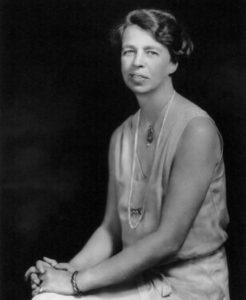
Eleanor as a young woman (National Park Service)
When she moved back to America, Eleanor worked at a settlement house on the Lower East Side. While there, she witnessed firsthand the struggles of immigrants and the poor and downtrodden.
FDR and Eleanor were distant cousins and first met in childhood. They reconnected later in life and dated in secret. Then, they finally made their relationship public and married. Eleanor’s uncle, President Theodore Roosevelt, gave her away at their wedding.
The couple had six children — Franklin Jr, Anna, James, Elliot, John and Franklin Jr (the first Franklin Jr died as a baby). The Roosevelt family split their time between DC, New York City, a summer home in Maine, and FDR’s childhood home in Hyde Park.
Eleanor removed herself from politics while FDR was the governor of New York. But then, he became sick with polio and Eleanor cared for him day and night until he recovered. She encouraged him to continue in politics when most people suggested he retire. She also agreed to hide his physical disabilities as much as possible. After that, they were political partners for the rest of his career.
Eleanor and FDR had a complicated relationship. After Eleanor found our that FDR had an affair with her secretary, she was devastated by the betrayal. And things were never the same again. The were political partners, but lived separate personal lives.
Glinda’s Gallery
Just the Facts
- Anna Eleanor Roosevelt was born on October 11, 1884. Both parents died by the time she was 10 years old. Her dad was a drunk and her mom was mean to her. After they died, she went to live with her grandmother, who was extremely strict. She attended Allenswood Academy.
- Eleanor married FDR on March 7, 1905 (he was a distant cousin of hers). They had 6 children and 23 grandchildren.
- Eleanor was first lady from 1933-1945. She was first lady longer than anyone (12 years, one month, one week, one day).
- Eleanor earned more money than FDR during most of their married years, sometimes over $100,000 per year. She donated all her earnings to charity.
- All four sons of FDR and Eleanor served in World War II, as well as their son-in-law.
- Once, she fed hot dogs to the King and Queen of England during their visit.
- Eleanor had the largest FBI file for many years (over 3,000 pages). She regularly received death threats and there were at least 10 assassination attempts on her life.
- Eleanor served as the US delegate to the United Nations twice (1945-1953 and 1961-1962). She even visited Hiroshima as a UN Delegate to witness the damage firsthand.
- In 1961, JFK appointed Eleanor as Chair of the “Commission on the Status of Women.” She died shortly before the Commission issued its final report.
- Eleanor died on November 7, 1962 at age 78. She suffered from tuberculosis during the last few years of her life and is buried at the Roosevelt family estate in Hyde Park, New York.
- Eleanor received 48 honorary degrees during her life. She was also posthumously awarded the United Nations Human Rights Prize. And she was nominated for the Nobel Peace Prize three times but never received it.
- Bill Clinton established the Eleanor Roosevelt Award for Human Rights in 1998 to honor those who defend human rights in America.
Want to Know More?
Goodwin, Doris Kearns. No Ordinary Time: Franklin & Eleanor Roosevelt: The Home Front in World War II (New York: Simon & Schuster, 2013).
Rowley, Hazel. Franklin and Eleanor: An Extraordinary Marriage (New York: Picador, 2011).
Anna Eleanor Roosevelt, The White House (https://www.whitehouse.gov/about-the-white-house/first-families/anna-eleanor-roosevelt/).
Eleanor Roosevelt Biography, Franklin D Roosevelt Presidential Library and Museum (https://www.fdrlibrary.org/er-biography).
Women Who Shaped the Universal Declaration, The United Nations (https://www.un.org/en/observances/human-rights-day/women-who-shaped-the-universal-declaration).
